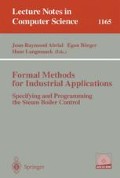Abstract
This paper presents a rigorous model of the dynamics of the physical process of the steam-boiler and of the embedding of the discrete program given in Chapter CW1 in the continuous environment. Program constants and variables are clearly distinguished from physical quantities, and it is shown, that under some conditions the program variables approximate the physical quantities. This relation between physical and program variables is, technically speaking, a coupling invariant. Hybrid and real-time aspects of the system are also considered, including several positive and negative results regarding the expected properties of the system. Some of them are impossibility results, in the sense that no (reasonable) controller program can solve some aspects of the problem properly.
This paper illustrates a simple method for combining different abstraction levels in the verification of industrial control programs. Programs are specified by their next-state relation (in first order logic) without real-time (but, if needed, using program clocks). The behavior of the environment is described by the physical laws that govern the dynamics of the process. Those two levels are bridged together by the specification of the real-time deadlines that the SW- and HW-implementation has to guarantee.
Supported in part by a BMBF grant from the German Federal Ministry of Education, Science, Research and Technology under contract number 01IS519A (project KORSYS)
Preview
Unable to display preview. Download preview PDF.
References
Jorge Cuéllar, Dieter Barnard, and Martin Huber. A Solution relying on the Model Checking of Boolean Transition Systems. In The RPC-Memory Specification Problem, to appear in LNCS, 1996.
Mark H. Klein, John P. Lehoczky, and Ragunathan Rajkumar. Rate-Monotonic Analysis for Real-Time Industrial Computing. Computer, pages 24–33, January 1990.
Leslie Lamport. Hybrid Systems in TLA+. Eds. Grossman, Nerode, Ravn, Rischel, 736:77–102, 1993.
L. Lamport. The Temporal Logic of Actions. ACM Transactions on Programming Languages and Systems, 16(3):872–923, May 1994.
Hans Rischel, Jorge Cuéllar, Simon MØrk, Anders P. Ravn, and Isolde Wildgruber. Development of Safety-Critical Real-Time Systems. In Proceedings of the SOFSEM '95, M.Bartosek, J.Staudek, J. Wiedermann (Eds), volume 1012 of LNCS, November 1995.
E. D. Sontag. Mathematical Control Theory. Springer, 1990.
Author information
Authors and Affiliations
Corresponding author
Editor information
Rights and permissions
Copyright information
© 1996 Springer-Verlag Berlin Heidelberg
About this chapter
Cite this chapter
Cuéllar, J.R., Wildgruber, I. (1996). The real-time behavior of the steam-boiler. In: Abrial, JR., Börger, E., Langmaack, H. (eds) Formal Methods for Industrial Applications. Lecture Notes in Computer Science, vol 1165. Springer, Berlin, Heidelberg. https://doi.org/10.1007/BFb0027237
Download citation
DOI: https://doi.org/10.1007/BFb0027237
Published:
Publisher Name: Springer, Berlin, Heidelberg
Print ISBN: 978-3-540-61929-1
Online ISBN: 978-3-540-49566-6
eBook Packages: Springer Book Archive

